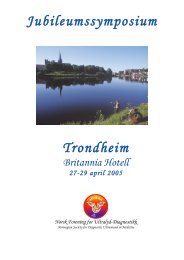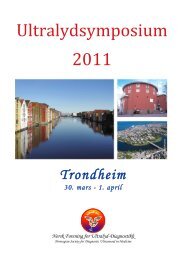Ultralydsymposium - NORSK FORENING FOR ULTRALYD ...
Ultralydsymposium - NORSK FORENING FOR ULTRALYD ...
Ultralydsymposium - NORSK FORENING FOR ULTRALYD ...
- No tags were found...
Create successful ePaper yourself
Turn your PDF publications into a flip-book with our unique Google optimized e-Paper software.
NFUD ultralydsymposium 2012Ultrasound Detection of Pneumothorax:Animal Laboratory Training Improves Diagnostic Competency and SpeedForfattere:Nils Petter Oveland, MD 1,2 , Hans Morten Lossius, MD, Ph.D 1 , RasmusAagaard, MD 3 , Jim Connolly, MD 4 , Erik Sloth, MD, DMsc ,3,5 , Lars Knudsen, MD, Ph.D 5 .Institusjon: 1 Department of Research and Development, Norwegian Air AmbulanceFoundation, Droebak, Norway. 2 Department of Anaesthesiology and Intensive Care,Stavanger University Hospital, Stavanger, Norway. 3 Institute of Clinical Medicine, AarhusUniversity, Aarhus, Denmark. 4 Emergency Department, Royal Victoria Infirmary,Newcastle-upno-Tyne, UK. 5 Department of Anaesthesiology and Intensive Care, AarhusUniversity Hospital Skejby, Aarhus, Denmark.Adresse:Norsk Luftambulanse Stavanger, G.Bloch Thorsensgate 10, 4019 StavangerKontaktinfo hovedforfatter:nils.petter.oveland@norskluftambulanse.no , 91314350Background:Animal laboratory training (ALT) improves performance of surgical skills such assaphenous cutdown, thoracotomy and cricothyroidotomy, but uncertainty exists withsimilar training for diagnostic procedures. Ultrasound (US) of the chest is very accurate indetecting pneumothorax (PTX), but the training requirements to perform theseexaminations needs to be defined.ObjectiveTo test whether ALT is associated with improved diagnostic competency and speed for USdetection of PTX in porcine models.Method:20 medical students without prior US experience attended a one-day course at an animallaboratory facility. The ALT program covered lectures of basic US theory, US machines,lung US and ended with hands-on training on porcine PTX models. Their diagnosticcompetency and speed were tested stepwise; first examination on four porcine modelsfollowed by individual feedback and a second identical final exam. A six months followupexamination ended the study. The outcome measures was sensitivity and specificity forUS detection of PTX, self reported diagnostic confidence and scan time.Results:From the first to the second exam the sensitivity went from 81.7% (CI95% ; 69.1-90.1%)to 100% (CI95% ; 94.3-100.0%) and the specificity from 90.0% (CI95% ; 82.0-94.8%) to98.8% (CI95% ; 92.3-99.9%). Self reported diagnostic confidence increased from 7.8points (1=bad and 10=excellent) to 8.8 points between the two examinations. Similar, themean time the student used decreased by over one minute, resulting in less than threeminutes scan time per lung. All students retained their diagnostic skills when tested sixmonths later.Conclusion:Different medical specialities can learn how to use thoracic US to accurately diagnosePTX. The ALT program using porcine PTX models increased diagnostic competency andspeed in a group of medical students without prior US experience and was associated withsustained diagnostic skills.Conflicts of interest:None











